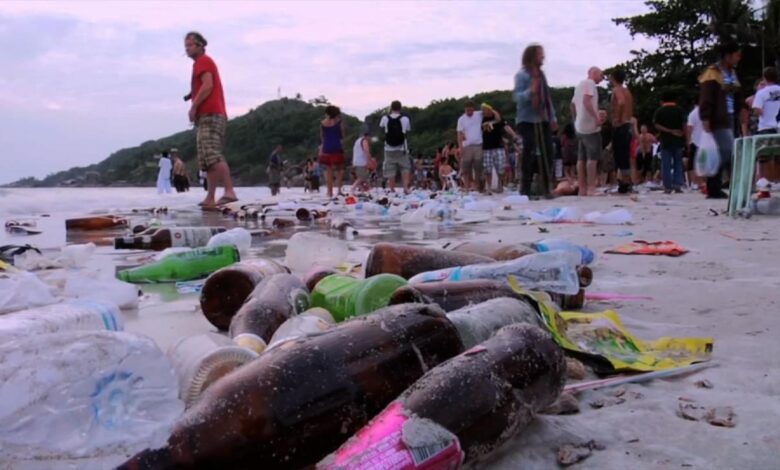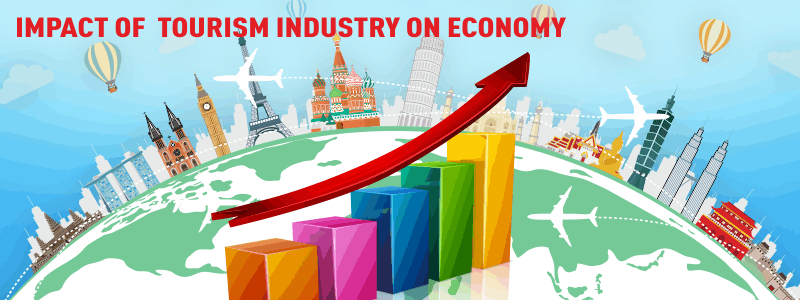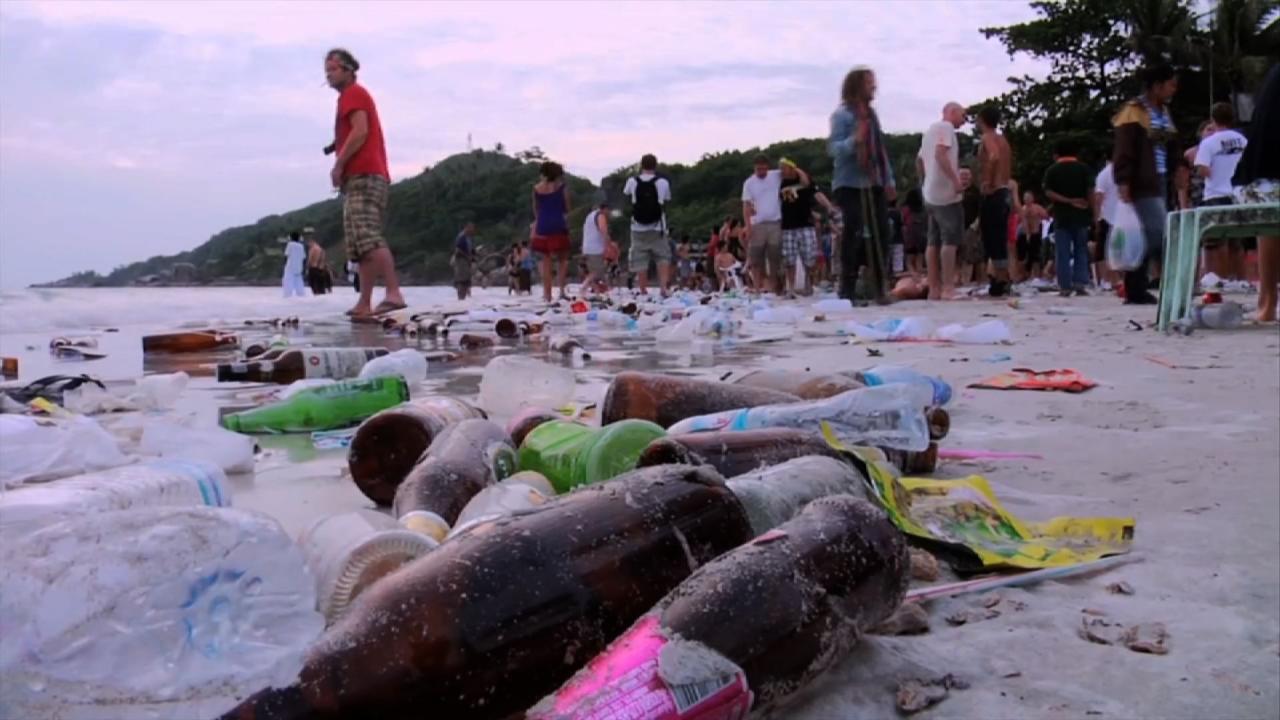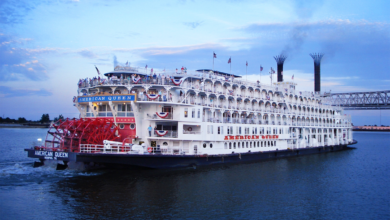
Tourism Growth, Destination Stress
As tourism grows so does stress on most popular destinations. This rise in travel brings a complex web of challenges for destinations worldwide, from strained infrastructure to environmental concerns and shifting social dynamics. We’ll explore the multifaceted impact of tourism on these iconic spots, examining the pressures they face and the potential solutions to balance growth with sustainability.
From bustling city centers to serene natural wonders, the influx of visitors puts a strain on resources. This essay delves into the intricate interplay between tourism’s economic benefits and its environmental and social costs, offering a nuanced perspective on the growing pains of popular destinations.
Introduction to the Impact of Tourism Growth

The burgeoning tourism industry, while driving economic growth and cultural exchange, often places immense pressure on popular destinations. This increased foot traffic and demand strain existing infrastructure, negatively impact the environment, and create social tensions. The quest for tourist dollars can sometimes overshadow the needs and well-being of local communities.The relationship between tourism growth and stress on destinations is complex.
While tourism brings economic benefits, it also brings significant challenges. These challenges manifest in various forms, impacting infrastructure, environmental sustainability, and social harmony. Destinations facing rapid tourism growth often experience infrastructure overload, environmental degradation, and shifts in social dynamics.
Infrastructure Strain
The increasing number of tourists puts a tremendous strain on the existing infrastructure of a destination. Roads, public transportation, water and sanitation systems, and energy grids struggle to keep up with the demands. This can lead to congestion, delays, and a decline in the quality of services offered to both tourists and residents. For example, cities like Venice, Italy, face immense pressure on their transportation networks and sewage systems due to the high volume of tourists.
The increased traffic volume and weight of tourism negatively impact the historical buildings.
Environmental Degradation
Tourism, particularly mass tourism, often leads to environmental degradation. Increased pollution from vehicles, waste generation, and the depletion of natural resources like water and forests are significant concerns. Overcrowding in fragile ecosystems can damage natural habitats and biodiversity. The increased demand for accommodation and infrastructure can result in deforestation and habitat loss. Examples include the Great Barrier Reef, facing coral bleaching and pollution due to increased tourism and boat traffic.
Social Dynamics and Cultural Impacts
Rapid tourism growth can significantly alter social dynamics and cultural practices within a destination. The influx of tourists can sometimes lead to cultural commodification and the erosion of traditional values. There can be a disconnect between tourists’ expectations and the reality of local communities. Local businesses may prioritize catering to tourists’ preferences over the needs of residents.
This is often seen in destinations where traditional markets and crafts are adapted to attract tourists, sometimes at the expense of authenticity and local traditions.
Different Types of Tourism and Their Impact on Stress
| Type of Tourism | Impact on Stress Levels |
|---|---|
| Mass Tourism | High stress on infrastructure, environment, and social dynamics. Often leads to overcrowding, pollution, and the commodification of culture. |
| Eco-Tourism | Potentially lower stress if managed sustainably. Focuses on minimizing environmental impact and supporting local communities. |
| Cultural Tourism | Can be both beneficial and stressful. Benefits include cultural exchange and preservation; potential stress involves the commodification of culture if not managed appropriately. |
| Adventure Tourism | Stress depends on the destination’s capacity to manage the activity level and maintain environmental integrity. Can be high in destinations with limited infrastructure or fragile ecosystems. |
Infrastructure Strain
Tourism’s rapid growth often outpaces the capacity of destinations to handle the influx of visitors. This leads to significant strain on infrastructure, impacting the quality of experience for tourists and the well-being of local communities. From congested roads and overflowing sewage systems to strained water supplies and inadequate waste management, the consequences can be profound.Increased tourism demands a corresponding investment in infrastructure, but often the pace of development lags behind the escalating visitor numbers.
This mismatch creates a vicious cycle, where infrastructure limitations contribute to a decline in the quality of the tourist experience, deterring future visitors and potentially harming the local economy.
Transportation Challenges
Growing tourism often leads to increased traffic congestion on roads, railways, and airports. This not only frustrates tourists but also disrupts the daily lives of residents. Traffic jams can extend travel times, making destinations less appealing. For instance, popular beach destinations frequently experience heavy traffic during peak season, hindering access for both residents and visitors.
Utility Strain
As tourist numbers surge, the demand for water, electricity, and sanitation services increases dramatically. Overwhelmed utilities struggle to meet the growing demand, resulting in shortages, power outages, and potential health risks. For example, in mountainous regions popular for hiking, increased tourism can lead to water scarcity during the dry season, impacting both tourists and locals.
Waste Management Pressures
Tourism generates a significant amount of waste, from discarded food to plastic packaging. If waste management systems are not adequately equipped to handle the increased volume, it can lead to environmental problems, impacting the natural beauty of the destination and the overall quality of life for residents. Coastal areas, for instance, often struggle to manage the large amounts of litter left behind by tourists.
Infrastructure Projects Addressing Strain
Numerous infrastructure projects are being implemented to address the challenges posed by growing tourism. These projects aim to improve transportation networks, enhance utility services, and improve waste management.
- Many coastal cities are constructing new or expanding existing ports and cruise terminals to manage the influx of cruise ships and their passengers. This allows for more efficient and organized passenger movement.
- Some destinations are investing in upgrading their water treatment plants and distribution networks to ensure reliable water supply for both residents and tourists.
- Other areas are developing advanced waste management systems, including waste sorting facilities and recycling programs, to minimize environmental impact.
Comparative Analysis of Infrastructure Challenges
The following table illustrates the diverse infrastructure challenges faced by different regions due to tourism growth. Note that these are not exhaustive, and many other factors contribute to the specific challenges in each region.
| Region | Primary Infrastructure Challenges | Examples of Solutions |
|---|---|---|
| Southeast Asian Islands | Overwhelmed ports, congested roads, and inadequate waste management. | Construction of new airports, expansion of port facilities, and improved waste sorting infrastructure. |
| Alpine Mountain Regions | Strain on water resources during peak seasons, and traffic congestion on mountain roads. | Water conservation initiatives, development of alternative transportation options (e.g., cable cars), and road improvements. |
| Mediterranean Coastal Areas | Congestion on coastal roads, strain on sewage and water systems, and litter accumulation. | Construction of new roads and public transport, upgrading wastewater treatment plants, and promoting responsible tourism practices. |
Environmental Consequences
Increased tourism, while bringing economic benefits, often comes at a significant environmental cost. The influx of visitors can strain natural resources, damage delicate ecosystems, and contribute to pollution, impacting the long-term viability of popular destinations. Understanding these consequences is crucial for developing sustainable tourism strategies.
Environmental Degradation Linked to Tourism
Tourism, though a powerful engine for economic growth, can inflict severe environmental damage if not managed responsibly. The sheer volume of tourists, combined with the infrastructure required to support them, often leads to resource depletion, habitat loss, and pollution. These impacts contribute directly to destination stress, reducing the quality of life for local communities and jeopardizing the natural beauty that attracts tourists in the first place.
As tourism booms, pressure mounts on popular destinations, leading to overcrowded attractions and strained resources. This often leads to a rise in stress for locals and businesses alike. However, it’s encouraging to see how individuals are stepping up to tackle challenges, like the recent ceremony honoring dozens of graduates at a transformational leadership ceremony, dozens of graduates honored at transformational leadership ceremony.
Perhaps these leaders can help devise solutions to alleviate the growing pains of thriving tourist hubs.
Various Environmental Stressors
Several factors contribute to the environmental degradation associated with tourism. Pollution, in its various forms, is a major concern. Air pollution from transportation, waste disposal issues, and the use of unsustainable energy sources all contribute to the deterioration of air and water quality. Furthermore, habitat loss and fragmentation occur as land is converted for hotels, resorts, and other tourism-related developments.
The demand for resources like water and timber also rises significantly, potentially leading to shortages and conflicts with local communities.
Resource Depletion
The increased demand for resources associated with tourism can lead to significant depletion. Water scarcity is a growing problem in many popular destinations, particularly those with arid climates. Over-extraction of water for tourism-related activities, combined with the needs of a growing population, can create severe water shortages, impacting local communities and ecosystems. Similarly, the exploitation of natural resources, such as timber and minerals, for construction and development can have devastating effects on forests and other natural areas.
Overfishing in coastal areas, often driven by the demand for seafood from tourists, also threatens marine ecosystems.
Habitat Loss and Fragmentation
Tourism development often requires land conversion, leading to habitat loss and fragmentation. The construction of hotels, roads, and other infrastructure can destroy natural habitats, reducing biodiversity and disrupting the delicate balance of ecosystems. Fragmentation of habitats isolates populations of plants and animals, limiting their ability to adapt and survive, thus contributing to the loss of biodiversity. The disruption of natural corridors, which allow animals to migrate and access resources, is another negative consequence of habitat loss.
Pollution
Pollution from various sources poses a serious threat to the environment in tourist destinations. Waste generation, from tourists and from the tourism industry itself, can overwhelm local waste management systems, leading to pollution of land and water. Improper sewage disposal and inadequate waste treatment facilities contribute to water pollution, affecting both human health and the health of aquatic ecosystems.
Noise pollution from transportation and activities like parties and loud events can also disrupt the natural soundscape and disturb wildlife.
Sustainable Tourism Practices
Implementing sustainable tourism practices is crucial to mitigating the negative environmental impacts. Sustainable tourism aims to balance economic development with environmental protection and social well-being. A range of strategies can be employed to achieve this balance.
| Sustainable Tourism Practice | Description |
|---|---|
| Eco-friendly accommodations | Hotels and resorts can adopt eco-friendly practices, such as using renewable energy sources, reducing water consumption, and minimizing waste generation. |
| Sustainable transportation | Encouraging the use of public transportation, cycling, or walking, and promoting electric vehicles can reduce carbon emissions and air pollution. |
| Waste management | Implementing comprehensive waste management systems, including recycling programs and composting facilities, can significantly reduce waste pollution. |
| Conservation efforts | Supporting local conservation organizations and participating in initiatives to protect endangered species and natural habitats can help maintain biodiversity. |
| Community engagement | Involving local communities in tourism planning and decision-making can ensure that tourism benefits both the environment and local populations. |
Social and Cultural Impacts

Tourism’s growth, while bringing economic benefits, often brings unforeseen social and cultural pressures to destinations. Communities face challenges adapting to increased visitor numbers, potentially altering their traditional ways of life and leading to conflicts between locals and tourists. Understanding these impacts is crucial for sustainable tourism development.The influx of tourists can significantly alter local customs and traditions, sometimes leading to their dilution or even distortion.
The desire to cater to tourists can incentivize modifications to cultural practices, potentially leading to a loss of authenticity. Preserving cultural heritage while balancing the needs of tourism is a complex undertaking requiring careful planning and community engagement.
Social Pressures on Communities
Tourism’s rapid growth can place considerable strain on local infrastructure, resources, and social fabric. Increased demand for housing, water, and sanitation can strain existing systems. This can lead to rising costs of living, potentially displacing residents who can no longer afford the increased prices. Competition for jobs, often with tourists taking precedence, can also create social unrest and resentment.
This dynamic needs to be carefully managed to avoid unintended consequences.
Alteration of Local Customs and Traditions, As tourism grows so does stress on most popular destinations
Tourism can inadvertently alter local customs and traditions, often for commercial gain. Authentic cultural expressions might be adapted or even fabricated to appeal to tourist preferences, resulting in a loss of cultural integrity. This commodification can erode the value and meaning of traditional practices, impacting the social fabric of the community.
Successful Community Engagement Strategies
Effective community engagement strategies are crucial for mitigating the negative impacts of tourism. These strategies focus on empowering local communities to participate in decision-making processes related to tourism development. Meaningful partnerships between tourism businesses and local residents are vital. Examples include participatory planning processes where local voices are heard and considered, and establishing fair labor practices to ensure locals benefit from the tourism industry.
Potential for Conflict Between Tourists and Locals
Disagreements between tourists and locals can arise from misunderstandings, cultural differences, and resource competition. Tourists may not always respect local customs and traditions, leading to friction. Misunderstandings can escalate if communication barriers exist, or if local resources are perceived as being unfairly prioritized for tourists. Strategies for managing these conflicts include education programs for both tourists and locals, promoting intercultural understanding, and ensuring that local communities benefit directly from tourism.
Economic Considerations
Tourism, while often perceived as a positive force for economic growth, presents a complex interplay of benefits and drawbacks. Its impact varies significantly depending on the destination, the type of tourism, and the local infrastructure. Examining these economic implications is crucial for sustainable tourism development, ensuring that the industry benefits all stakeholders.
Economic Benefits of Tourism Growth
Tourism generates substantial revenue for host countries. This income can be used to fund infrastructure projects, improve public services, and stimulate economic activity in related sectors like transportation, hospitality, and retail. For example, the tourism industry in the Caribbean islands often drives significant economic growth, contributing to employment and raising living standards in the region. Furthermore, foreign exchange earnings from tourism can stabilize a country’s currency and increase its international standing.
Job Creation and Economic Development Potential
Tourism fosters job creation across a range of industries. From hotel staff and tour guides to restaurant workers and artisans, the sector provides employment opportunities, particularly in developing nations. This can lead to poverty reduction and improved livelihoods. However, the quality and stability of these jobs are important considerations. For example, the rise of ecotourism in Costa Rica has led to job creation in the environmental sector, while also promoting sustainable practices.
As tourism booms, the pressure on popular destinations intensifies. Imagine the relentless pace and meticulous planning required for a top-tier culinary experience, like a day in the life of a high-profile executive chef like Hal, a day in the life hal executive chef. From sourcing the freshest ingredients to managing a bustling kitchen, the demands are enormous.
This highlights how the growth of tourism often translates to immense stress on the destinations themselves, from infrastructure strain to environmental impacts.
Potential for Exploitation and Inequality
While tourism can create jobs, it can also exacerbate inequalities if not managed carefully. Profits might not always be distributed equitably among local communities, with foreign businesses and investors potentially benefiting more. Exploitation of workers, including low wages and poor working conditions, can occur if regulations are weak or enforcement is lacking. In some cases, tourism can displace local communities and traditional livelihoods.
For example, the expansion of luxury resorts in coastal areas might displace local fishing communities.
Economic Impact of Different Types of Tourism
Different types of tourism have varying economic impacts on destinations. For instance, mass tourism, characterized by large numbers of visitors, can lead to strain on infrastructure, while also potentially creating jobs. However, this strain often results in higher prices for locals and environmental degradation. Ecotourism, in contrast, aims to minimize environmental impact and often supports local communities through fair trade practices and direct economic benefits.
As tourism explodes, the pressure on popular destinations like Waikiki is only increasing. The recent opening of the Alohilani Waikiki Beach alohilani waikiki beach makes its opening official is a great example of this, adding another layer of excitement and potential strain to the already bustling area. This influx of visitors will undoubtedly impact local communities and the environment, highlighting the ongoing tension between growth and sustainability in popular tourist hotspots.
This can lead to a more equitable distribution of tourism revenue and support for local communities and businesses. Cultural tourism, on the other hand, can contribute to preserving and promoting local traditions and crafts, potentially generating income for local artisans and businesses.
Management Strategies
Tourism’s explosive growth, while economically beneficial, often strains resources and negatively impacts the environment and local communities. Effective management strategies are crucial to ensuring tourism’s long-term sustainability and positive impact. These strategies must balance economic gains with environmental protection and social well-being. Careful planning and implementation are key to mitigating the negative consequences of uncontrolled tourism.Sustainable tourism management requires a multifaceted approach.
It necessitates proactive measures to control visitor numbers, preserve natural resources, protect cultural heritage, and ensure fair compensation for local communities. These strategies need to be adaptable and responsive to evolving circumstances, recognizing that tourism’s impact is dynamic and context-dependent.
Effective Strategies for Managing Tourism Growth
Effective strategies encompass a range of measures designed to control visitor numbers, distribute tourist activity across time and space, and minimize the environmental and social impacts. These strategies must be carefully integrated and adaptable to specific contexts. A key element is the development of clear regulations and policies that Artikel acceptable levels of tourism activity within a destination.
- Demand Management: Strategies for managing tourism demand involve proactive measures to regulate the flow of tourists. This can include setting visitor quotas, implementing pricing mechanisms to influence demand, and promoting tourism during off-peak seasons. For instance, Amsterdam uses variable pricing for accommodation to discourage overtourism during peak periods.
- Infrastructure Development and Investment: Tourism-related infrastructure needs careful planning and investment to ensure it can accommodate increasing visitor numbers without compromising environmental quality or exceeding carrying capacity. This involves strategically building or upgrading transportation networks, accommodation facilities, and other supporting services. Examples include the construction of high-speed rail lines to ease congestion in popular tourist destinations, or developing eco-friendly hotels that minimize their environmental footprint.
- Environmental Protection Measures: Effective strategies to protect natural resources are paramount to sustainable tourism. This involves establishing protected areas, enforcing environmental regulations, promoting eco-tourism practices, and educating tourists about responsible behavior. For example, national parks often implement entry fees or visitor quotas to manage the impact of large numbers of tourists on fragile ecosystems.
Role of Local Governments and Stakeholders
Local governments play a pivotal role in developing and implementing sustainable tourism strategies. Their involvement is critical for effectively managing the economic, environmental, and social impacts of tourism. Active participation from all stakeholders is essential for a successful tourism management plan.
- Collaboration and Partnerships: Successful tourism management requires collaboration among local governments, businesses, community groups, and NGOs. This collaborative approach ensures that all perspectives are considered and that solutions are tailored to the specific needs of the destination.
- Community Engagement: Involving local communities in the planning and implementation of tourism initiatives is crucial for ensuring that tourism benefits local residents. This can involve providing opportunities for employment and entrepreneurship within the tourism sector, as well as incorporating local knowledge and traditions into tourism offerings.
- Education and Awareness Campaigns: Raising awareness about sustainable tourism practices among tourists, businesses, and residents is vital. This can involve educational programs, promotional materials, and partnerships with tourism operators to encourage responsible practices.
Elements of a Sustainable Tourism Strategy
A sustainable tourism strategy must address multiple interconnected elements. This strategy should encompass economic, environmental, and social considerations to ensure a balanced and positive impact.
| Element | Description |
|---|---|
| Environmental Impact Assessment | Thorough evaluation of the potential environmental consequences of tourism development. |
| Visitor Capacity Management | Strategies to control visitor numbers and distribution, avoiding exceeding carrying capacity. |
| Community Involvement | Ensuring that local communities benefit economically and socially from tourism. |
| Economic Viability | Developing tourism strategies that are financially sustainable for both businesses and the community. |
| Cultural Preservation | Protecting and promoting local culture and traditions. |
Case Studies: As Tourism Grows So Does Stress On Most Popular Destinations
Tourism’s rapid growth often brings about significant challenges for destinations. Understanding the specific pressures faced by popular locations is crucial for developing effective management strategies. This section delves into a compelling case study, examining the factors contributing to stress and proposing solutions that can be applied elsewhere.
The Case of Bali, Indonesia
Bali, renowned for its stunning beaches, lush rice paddies, and vibrant culture, has experienced a dramatic increase in tourist arrivals in recent years. This surge in popularity has brought about a range of challenges, impacting the environment, local communities, and the overall quality of life for residents.
Factors Contributing to Stress
The escalating influx of tourists has placed immense strain on Bali’s infrastructure. Increased traffic congestion, strain on water resources, and a growing demand for housing are among the primary concerns. Furthermore, the rise in tourism has inadvertently led to the degradation of natural landscapes, a decline in traditional cultural practices, and rising costs of living for locals. The pressure to accommodate large numbers of tourists has also sometimes led to a decline in the quality of local services.
Environmental Impacts
The influx of tourists has put immense pressure on Bali’s natural resources. Increased waste generation, pollution from transportation, and the construction of new hotels and infrastructure have significantly impacted the island’s fragile ecosystem. Overuse of beaches and coral reefs by tourists can lead to damage and loss of biodiversity.
Social and Cultural Impacts
Tourism can lead to a homogenization of local cultures as traditions are adapted to attract tourists. Cultural practices, which are often deeply rooted in local heritage, can be diluted or even lost. The influx of tourists can also exacerbate existing social inequalities, such as the widening gap between rich and poor.
It’s a well-known fact that as tourism booms, so does the pressure on popular destinations. Take Jamaica, for example, where a projected surge in winter arrivals means ensuring adequate transport is crucial. This is why, as highlighted in the recent article on airlift a priority as jamaica confident of winter arrivals boost , a reliable airlift is a top priority.
Ultimately, though, even with efficient transport, the growing number of visitors will inevitably lead to more strain on infrastructure and resources in destinations like Jamaica, just like other popular tourist hotspots.
Economic Considerations
While tourism generates considerable revenue, its economic benefits are not always evenly distributed. Increased prices for goods and services can place a burden on local residents, and some may struggle to find employment. The tourism sector’s dominance in the economy can make it vulnerable to external shocks.
Mitigation Strategies
Sustainable tourism practices are essential for minimizing the negative impacts of high tourism growth. Implementing stricter environmental regulations, promoting responsible tourism practices among visitors, and supporting local businesses can help mitigate the problems. Developing robust infrastructure to manage the increased traffic flow, ensuring adequate water supplies, and promoting local economic development are all crucial components of a sustainable tourism strategy.
Applying Strategies to Other Destinations
The strategies employed to address the challenges faced by Bali can be adapted and implemented in other popular destinations experiencing similar pressures. For instance, implementing a “tourist tax” can help fund infrastructure improvements and community development projects. Promoting responsible tourism practices through educational campaigns and partnerships with local communities can foster a more sustainable and equitable tourism experience for all.
As tourism booms, pressure mounts on popular destinations. This escalating strain is often evident in various ways, from infrastructure struggles to increased prices. Recent events like the Air Jamaica CEO’s resignation, sparking protests ( air jamaica ceo resignation prompts protest ), highlight the complex web of issues that arise when visitor numbers surge. Ultimately, as the world keeps traveling, the challenges faced by these destinations will continue to be significant.
Encouraging diversification of the economy, alongside the tourism sector, can provide a safety net for destinations that depend heavily on tourism revenue.
Visual Representations
Visual representations are crucial for understanding the multifaceted impacts of tourism. Images and graphics can convey complex issues in a concise and impactful way, allowing for easier comprehension and fostering a deeper understanding of the topic. They are particularly valuable for communicating the potential consequences of uncontrolled tourism growth and highlighting strategies for sustainable development.
A Depiction of Stress from Overcrowding
Imagine a bustling coastal town, a popular tourist destination. The image shows a narrow, crowded street filled with tourists jostling for space. Vendors hawk their wares amidst the throng, and a long line of tourists stretches out in front of a restaurant. The air is thick with the sounds of chattering voices, the rhythmic pounding of waves muted by the noise.
This visual immediately communicates the strain placed on infrastructure, services, and the local community by an influx of visitors. The visual emphasis is on congestion and the disruption of the local environment.
A Sustainable Tourism Scene
A different image depicts a picturesque mountain village, with hikers gently traversing trails. Local guides lead small groups of tourists, ensuring minimal impact on the natural surroundings. The image showcases local artisans demonstrating their crafts to tourists. Visitors interact respectfully with the environment and local culture, respecting the area’s delicate balance. The focus here is on the positive relationship between tourism and local communities and the environment, highlighting sustainable practices.
A Model of Well-Managed Tourism
This image showcases a well-managed tourism area, a blend of bustling activity and serene nature. A large, well-maintained park sits beside a scenic river. Local businesses, cafes, and shops are strategically placed, providing services to tourists and supporting the local economy. There are clear pathways, and waste disposal systems are evident, showcasing a commitment to cleanliness and environmental responsibility.
The area is meticulously designed to minimize environmental impact while maximizing visitor experience and economic benefits for the local community.
A Graphic Comparing Tourism Models
A graphic illustrating various tourism models could be created using a bar chart or a side-by-side comparison. The x-axis could represent different tourism models, such as mass tourism, ecotourism, or cultural tourism. The y-axis would show the environmental impact (e.g., carbon emissions, waste generation, water consumption). The graphic could also include a column representing social and economic impacts (e.g., job creation, income generation, cultural preservation).
Different colors could highlight the relative environmental and social impact of each model. This visual representation would effectively demonstrate the contrasting impacts of various tourism models, allowing for comparisons and highlighting the importance of sustainable practices.
Closing Notes
In conclusion, the increasing popularity of destinations presents a delicate balancing act between economic gain and environmental, social, and infrastructural well-being. Sustainable tourism practices, proactive management strategies, and a deep understanding of the specific needs of each destination are crucial to mitigating the negative impacts and ensuring that tourism fosters a positive legacy for generations to come. Ultimately, it’s about finding a harmonious equilibrium that benefits both visitors and the local communities.
Query Resolution
What are some examples of destinations experiencing high tourism stress?
Many popular destinations, including cities like Rome, Venice, and popular coastal areas, face issues like overcrowding, traffic congestion, and strain on local resources. Even smaller, less-developed areas often experience similar pressures when tourism rapidly increases.
How can destinations mitigate the negative impacts of tourism?
Implementing sustainable tourism strategies, such as promoting eco-tourism, limiting visitor numbers in peak seasons, investing in infrastructure improvements, and involving local communities in decision-making processes, are all key steps towards managing the challenges effectively.
What is the difference between mass tourism and eco-tourism?
Mass tourism often prioritizes volume and affordability, leading to significant strain on resources and local communities. Eco-tourism, on the other hand, emphasizes environmental responsibility and supports local economies and cultures, aiming to minimize negative impacts.
What role do local governments play in managing tourism?
Local governments are critical in implementing policies that encourage sustainable tourism practices, from setting visitor limits to enforcing environmental regulations. They also play a vital role in community engagement and ensuring that tourism benefits all stakeholders.






